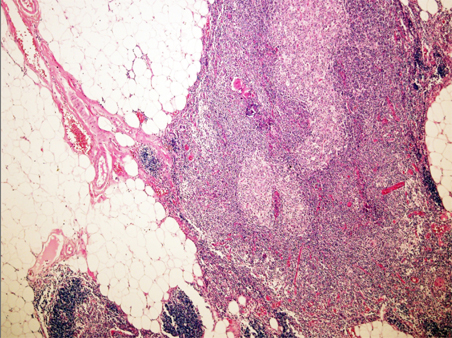Yonsei Med J.
2008 Dec;49(6):987-992. 10.3349/ymj.2008.49.6.987.
Transsternal Maximal Thymectomy is Effective for Extirpation of Cervical Ectopic Thymic Tissue in the Treatment of Myasthenia Gravis
- Affiliations
-
- 1Department of Thoracic and Cardiovascular Surgery, Yonsei University College of Medicine, Seoul, Korea. ik2653@yuhs.ac
- 2Department of Pathology, Yonsei University College of Medicine, Seoul, Korea.
- KMID: 1782948
- DOI: http://doi.org/10.3349/ymj.2008.49.6.987
Abstract
- PURPOSE
Extensive extirpation of cervico-mediastinal adipose tissue increases the chance of removing ectopic thymic tissues, thus potentially improving the prognosis of myasthenia gravis after thymectomy. We sought to increase efficacy and safety of transsternal maximal thymectomy (TSMT). MATERIALS AND METHODS: Twenty four patients who underwent TSMT from July 2006 to June 2007 were retrospectively reviewed and compared with 73 patients who underwent transsternal extended thymectomy (TSET) from January 2004 to May 2006. Ectopic thymic tissue in additionally excised cervicomediastinal fat tissue was examined histologically. RESULTS: In TSMT group, operation time, amount of cumulative drainage and duration of drainage were significantly higher than TSET group. However, the difference in hemoglobin count, amount of transfusion, duration of intensive care, postoperative hospital stay, and complication rates were not statistically different. There was no operative mortality in either group. Ectopic thymic tissue was found in 50% of patients. All patients had ectopic thymic tissues in the cervical area. Two patients had additional ectopic tissue in the aortopulmonary window, and 1 patient had ectopic tissue at posterior of the left bracheocephalic vein and lateral of the right phrenic nerve. CONCLUSION: TSMT is more effective in the extirpation of ectopic thymic tissues than TSET without significant impairment of safety, especially in the cervical area.
Keyword
MeSH Terms
Figure
Reference
-
1. Richman DP, Agius MA. Treatment of autoimmune myasthenia gravis. Neurology. 2003. 61:1652–1661.2. Gronseth GS, Barohn RJ. Practice parameter: Thymectomy for autoimmune myasthenia gravis (an evidence-based review): Report of the Quality Standards Subcommittee of the American Academy of Neurology. Neurology. 2000. 55:7–15.
Article3. Jaretzki A 3rd, Wolff M. "Maximal" thymectomy for myasthenia gravis. Surgical anatomy and operative technique. J Thorac Cardiovasc Surg. 1988. 96:711–716.4. Zieliński M, Kuzdzal J, Szlubowski A, Soja J. Transcervical-subxiphoid-videothoracoscopic "maximal" thymectomy-operative technique and early results. Ann Thorac Surg. 2004. 78:404–409. discussion 409-10.
Article5. Park IK, Choi SS, Lee JG, Kim DJ, Chung KY. Complete stable remission after extended transsternal thymectomy in myasthenia gravis. Eur J Cardiothorac Surg. 2006. 30:525–528.
Article6. Calhoun RF, Ritter JH, Guthrie TJ, Pestronk A, Meyers BF, Petterson GA, et al. Results of transcervical thymectomy for myasthenia gravis in 100 consecutive patients. Ann Surg. 1999. 230:555–559. discussion 559-61.
Article7. Shigemura N, Shiono H, Inoue M, Minami M, Ohta M, Okumura M, et al. Inclusion of the transcrvical approach in video-assisted thoracoscopic extended thymectomy (VATET) for myasthenia gravis: a prospective trial. Surg Endosc. 2006. 20:1614–1618.8. Jaretzki A 3rd. Thymectomy for myasthenia gravis: analysis of controversies-patient management. Neurologist. 2003. 9:77–92.
Article9. Zieliński M, Kuzdzał J, Szlubowski A, Soja J. Comparison of late results of basic transsternal and extended transsternal thymectomies in the treatment of myasthenia gravis. Ann Thorac Surg. 2004. 78:253–258.10. Chen H, Doty JR, Schlossberg L, Bulkley GB. Technique of thymectomy by anterior-superior cervicomediastinal exenteration. J Am Coll Surg. 2002. 195:895–900.11. Masaoka A, Yamakawa Y, Niwa H, Fukai I, Kondo S, Kobayashi M, et al. Extended thymectomy for myasthenia gravis patients: A 20-year review. Ann Thorac Surg. 1996. 62:853–859.
Article12. Scott W, Detterbeck F. Transsternal thymectomy for myasthenia gravis. Semin Thorac Cardiovasc Surg. 1999. 11:54–58.
Article13. Jaretzki A 3rd, Penn AS, Younger DS, Wolff M, Olarte MR, Lovelace RE, et al. "Maximal" thymectomy for myasthenia gravis. Results. J Thorac Cardiovasc Surg. 1988. 95:747–757.14. Ashour MH, Jain SK, Kattan KM, Al-Daeef AQ, Abdal Jabbar MS, al-Tahan AR, et al. Maximal thymectomy for myasthenia gravis. Eur J Cardiothorac Surg. 1995. 9:461–464.
Article15. Essa M, El-Medany Y, Hajjar W, Hariri Z, Al-Mulhim F, Salih M, et al. Maximal thymectomy in children with myasthenia gravis. Eur J Cardiothorac Surg. 2003. 24:187–189. discussion 190-1.
Article16. Fukai I, Funato Y, Mizuno T, Hashimoto T, Masaoka M. Distribution of thymic tissue in the mediastinal adipose tissue. J Thorac Cardiovasc Surg. 1991. 101:1099–1102.
Article17. Ashour M. Prevalence of ectopic thymic tissue in myasthenia gravis and its clinical significance. J Thorac Cardiovasc Surg. 1995. 109:632–635.
Article18. de Perrot M, Bril V, McRae K, Keshavjee S. Impact of minimally invasive trans-cervical thymectomy on outcome in patients with myasthenia gravis. Eur J Cardiothorac Surg. 2003. 24:677–683.19. Ferguson MK. Transcervical thymectomy. Semin Thorac Cardiovasc Surg. 1999. 11:59–64.
Article20. Mantegazza R, Baggi F, Bernasconi P, Antozzi C, Confalonieri P, Novellino L, et al. Video-assisted thoracoscopic extended thymectomy and extended transsternal thymectomy (T-3b) in non-thymomatous myasthenia gravis patients: remission after 6 years of follow-up. J Neurol Sci. 2003. 212:31–36.
Article


